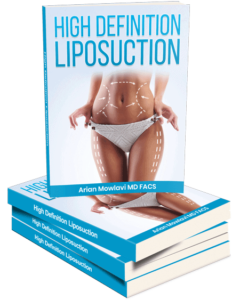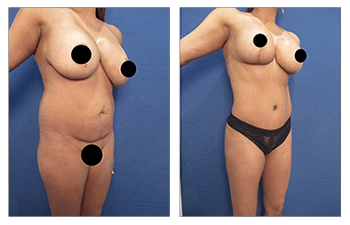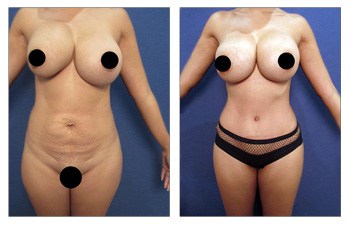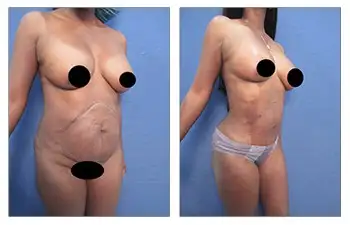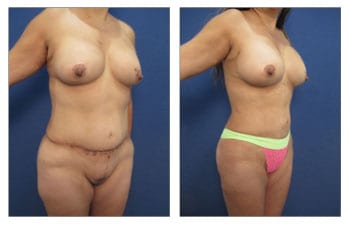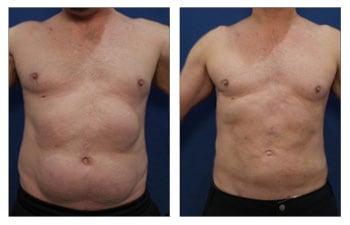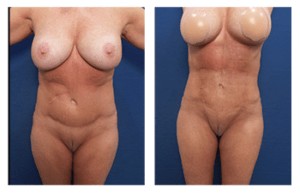WANT THE CONFIDENCE THAT COMES WITH
KNOWING YOU LOOK YOUR BEST?
High Definition Liposuction Revision CASE STUDIES
High Definition Liposuction Revision Surgery CASE STUDIES
High Definition Liposuction Revision
High Definition Liposuction Revision describes the correction of the entire gamut of botched liposuction outcomes. Poor liposuction outcomes can result from a variety of causes and these include:
- Skin contour waviness or asymmetry; this complication occurs when the deeper fat layer is removed unevenly. For optimal results following traditional liposuction, the deep layer must be removed entirely and uniformly. If the traditional liposuction provider lacks expertise, he/she may inadvertently leave the fat behind creating wavy irregularities.This complication occurs most frequently when liposuction is performed under local anesthesia with the patient awake. When nearing the end of fat removal, the last bit of fat is intimately associated with the muscle tissues making removal of this last fat tissue extremely painful. As a result, patients will ask their surgeon to stop liposuctioning prior to their completion of deep fat removal.
- Skin contour divots; this complication occurs when attempts are made by the liposuction provider to remove superficial fat. The superficial fat is universally composed of fat pads that are crisscrossed by a web of collagen pillars, called retaining ligaments, that provide stability to the skin.When attempts are made to pierce the superficial fat with a cannula, the cannula will get wedged and stuck. In fact, it is not feasible to clear out the superficial fat because of this phenomenon; any attempts to remove fat from this region will result in grooves and divots that are unsightly.
- Paradoxical adipose hyperplasia (PAH); PAH has been coined to describe the overgrowth of the deep fat once the superficial fat has been eliminated using topical cryotherapy (branded as Coolsculpting). It is believed that the superficial fat creates a compression hindrance to deep fat growth.Once this layer has been compromised and with patient weight gain, this deeper fat grows unimpeded when compared to its adjacent fat which was untreated.
- Skin roll deformities; Skin roll deformities and/or skin redraping irregularities refers to a generalized deformity of the skin contour that arises when redundancy in the skin has been created and/or not accommodated for. Patients who are left with skin redundancy following liposuction will observe random redraping of skin into operated looking and deformed appearance.
All of these botched results can be corrected with VASER liposuction since VASER liposuction removes all fat comprehensively from both the deep and superficial layers.
Only with uniform removal of all of the fat from both layers can you be assured that all of the deformities above will be resolved. Resolution of deformities will include the elimination of divots in the superficial layer, elimination of asymmetry or wave-like deformities, and correction of PAH deformities. If skin redundancy is present, then either Renuvion skin tightening or actual skin reduction using a mini-tucking procedure is used to strategically tighten the skin and eliminate any skin roll deformities.
Description:
- Procedure: Correction of any contour irregularities created by ineffective fat removal techniques and/or skin deformities arising from unmanaged skin redundancies.
- Length: 3 to 5 hours dependent on the number of areas needing correction; in general revision, liposuction requires 30 to 40 % more treatment time than areas were previously untreated.
- Anesthesia: General anesthesia.
- Place of Treatment: Outpatient surgical suite or hospital operating room.
Side Effects:
Prolonged operative times. Prolonged operative times should be expected since the removal of previously treated areas is associated with increased scar tissue build up that requires increased Vaser times to completely emulsify prior to liposuction.
- Partial loss of fat grafting volume. If you have had any type of prior liposculpture such as cool sculpting, Smart liposuction, or traditional liposuction, your fat quality will likely be suboptimal for fat transfer. Patients should be warned of only partial BBL volume take.
- Skin compromise. Since increased Vaser times and more aggressive liposuction must be performed to remove all of the fat and scar tissue, the overlying skin can become compromised. Early detection is critical to avoid any permanent damage to the skin. When skin compromise is detected, further Vaser and/or liposuction of that area should be avoided. In addition, the topical application of Nitro paste will allow for compromised tissues to be reverted to viable skin.
- Recovery: The recovery for revision high definition liposuction ranges longer than routine high definition liposuction procedures since longer operative times and more aggressive contouring must be accomplished. High definition liposuction revision cases will typically require approximately 2 weeks for recovery.
Duration of Results: Patients are universally pleased with revision high definition liposuction results as the corrections are definitive and permanent.
Frequently Asked Questions:
What does High Definition Liposuction Revision involve?
High definition liposuction revision entails correction of any and all deformities created by ineffective fat removal. By uniform and comprehensive removal of all fat layers using VASER technology, patients are ensured definitive and permanent correction of all of their deformed areas. When minimal to moderate skin redundancy is present Renuvion technology can be used to tighten the skin without the need for more invasive surgical cutting maneuvers. When moderate to severe skin redundancy is present, smaller tucking procedures may be strategically positioned and used to eliminate redundant skin and subsequent contour deformities.
Am I a good candidate for High Definition Liposuction Revision?
You are a good candidate for high definition liposuction revision if you are dissatisfied with the appearance of your body contour following previously performed fat removal procedure. Whether you feel that your results appear operated looking or whether there are contour irregularities such as divots, asymmetry, or skin rolls, all of these deformities can be corrected using high definition liposuction revision.
How do I plan for my High Definition Liposuction Revision?
You must plan for your high definition liposuction revision in advance. First of all, you have to recognize that your surgery will require more aggressive fat removal and thus require you to have a longer period for recovery; whereas routine high definition liposuction requires 1 week for recovery, high definition liposuction revision will require on the order of 2 weeks for full recovery.
What results can I expect after High Definition Liposuction Revision?
You can expect to achieve stunning results following high definition liposuction revision with elimination of all of your deformities. Since uniform and comprehensive removal of all fat layers is accomplished, your outcomes will typically be permanent.
Where will my High Definition Liposuction Revision be performed?
Your high definition liposuction revision procedure will be performed in a surgical facility or hospital setting.
Patient-Specific Questions:
Is it possible to revise areas that have been scarred following botched liposuction?
High definition liposuction revision utilizes Vaser technology that emits an ultrasound wave that is able to not only emulsify fat from all layers of the body prior to removal, but also able to break up any scar tissue that may have formed from prior surgery. Its effectiveness in removing scar tissue should not be surprising if you consider that Vaser alone is capable of removing all of the glandular/discoid tissue underneath the nipple and areola in gynecomastia patients. Traditionally, gynecomastia surgery require direct excision of this discoid tissue, but with the advent of ultrasound energy, this tissue can now be removed definitively with Vaser liposuction alone.
How does Vaser technology allow for revision of prior botched fat removal procedures?
Vaser technology utilizes ultrasound energy to literally emulsify any residual fat cells that were left after a botched fat removal procedure. This energy allows all layers of fat which include the superficial and/or deep layers to be removed comprehensively. As such, regardless of whether the deep fat was removed unevenly or the superficial fat was removed inappropriately, all of the superficial and deep fat is removed universally. In doing so, patients are ensured a smooth and permanent correction of your deformities.
What is paradoxical adipose hyperplasia (PAH) and how does high definition liposuction revision ensure definitive correction?
Paradoxical adipose hyperplasia (PAH) involves overgrowth of the deep fat layer following cryotherapy (Coolsculpting) and subsequent patient weight gain. Cryotherapy results in removal of the superficial fat layer only in the treated areas. Unfortunately, this treatment then results in loss of pressure inhibition on the deeper fat if weight gain follows. Patients with PAH demonstrate localized areas of deep fat overgrowth and resulting skin growth that creates discrete mound deformities. Vaser technology allows for definitive removal of this deep fat in the cryotreated areas as well as uniform removal of superficial and deep from adjacent regions. As a result, the entire patient can be debulked of unwanted fat universally. In addition, Renuvion skin tightening is used to tighten any skin redundancy following fat removal to avoid a secondary contour deformity. To date, patients that are two years out from PAH correction using high definition liposuction revision, have demonstrated on reoccurrence of their deformities.

